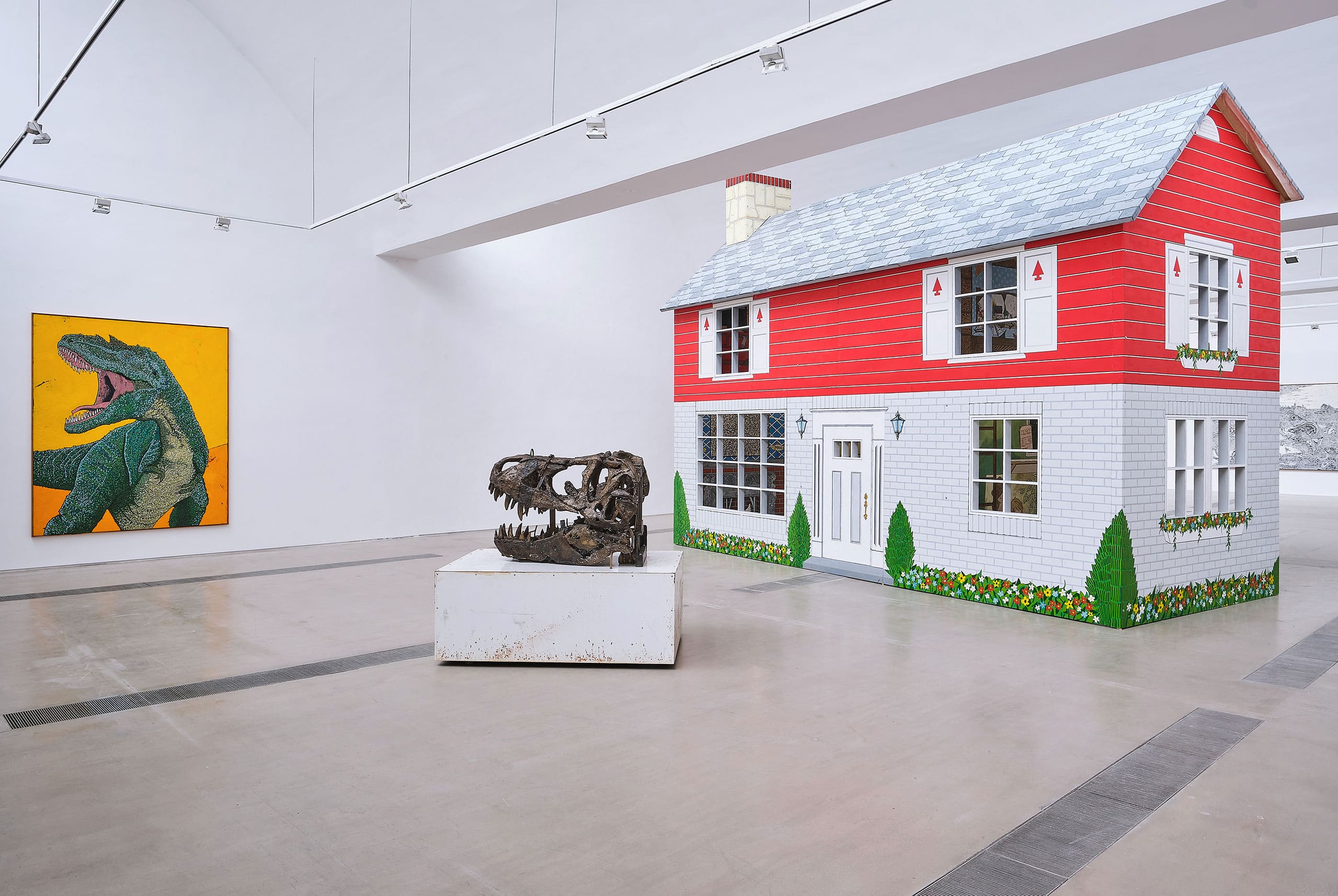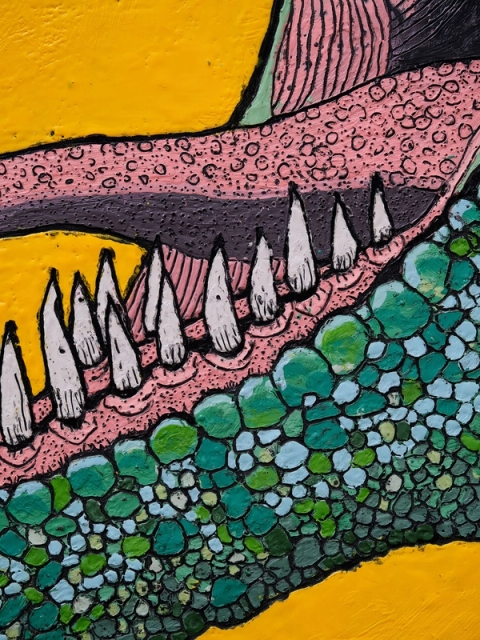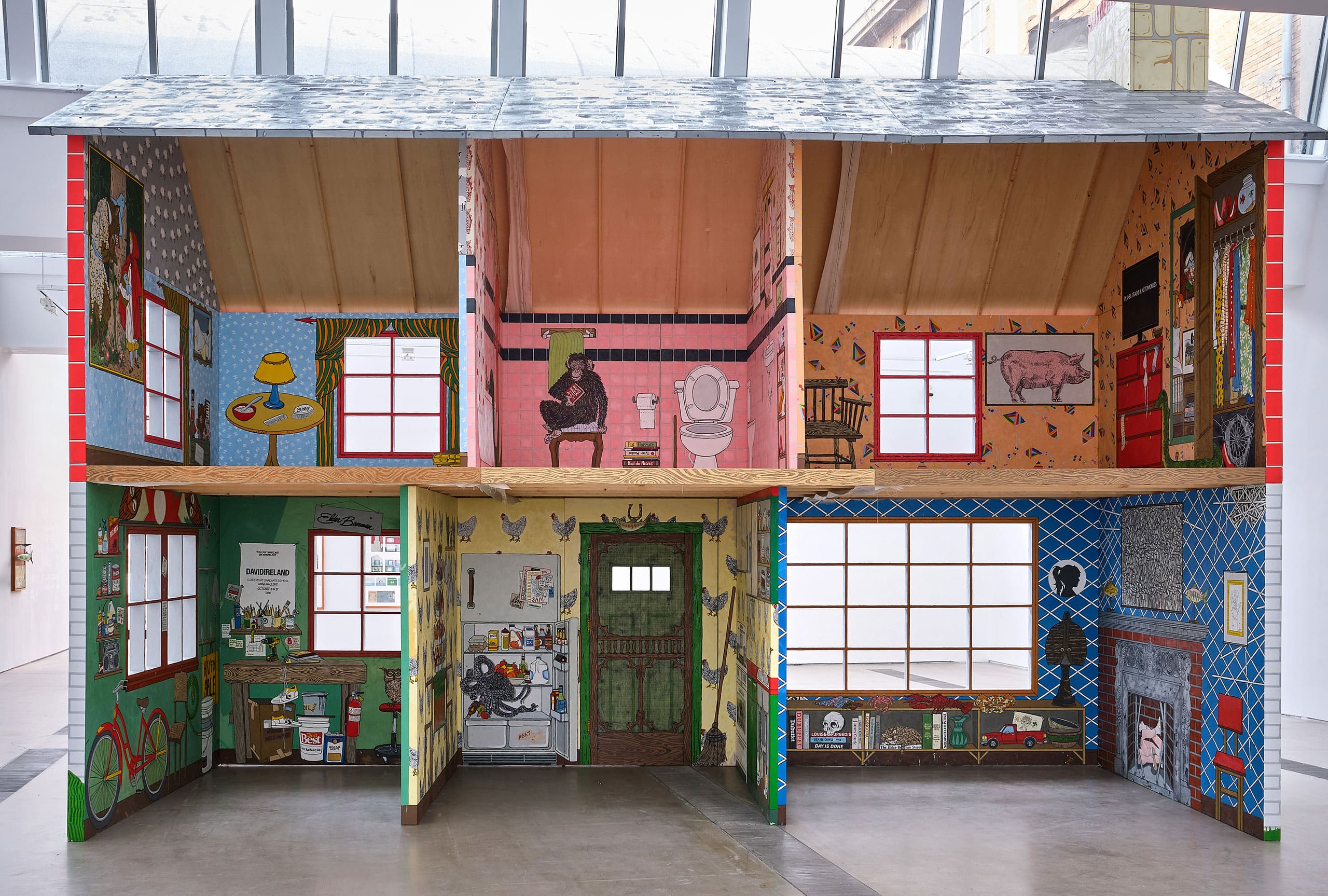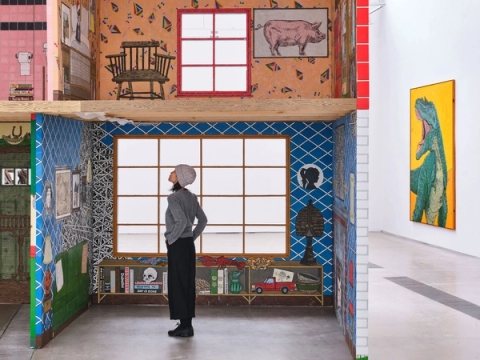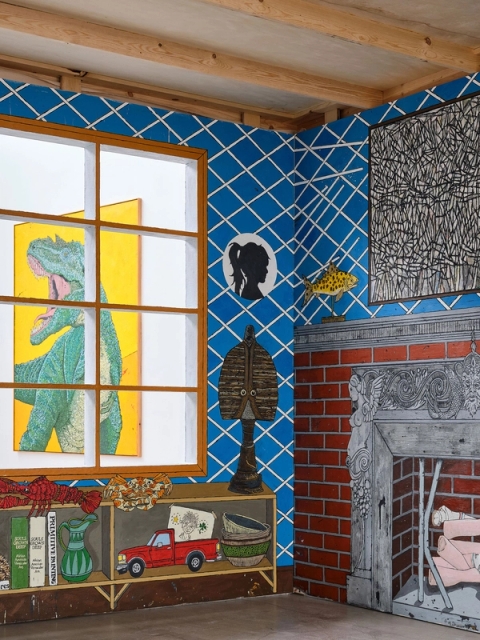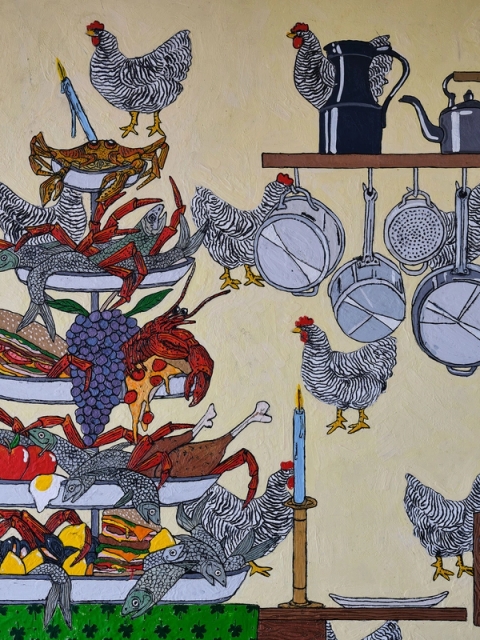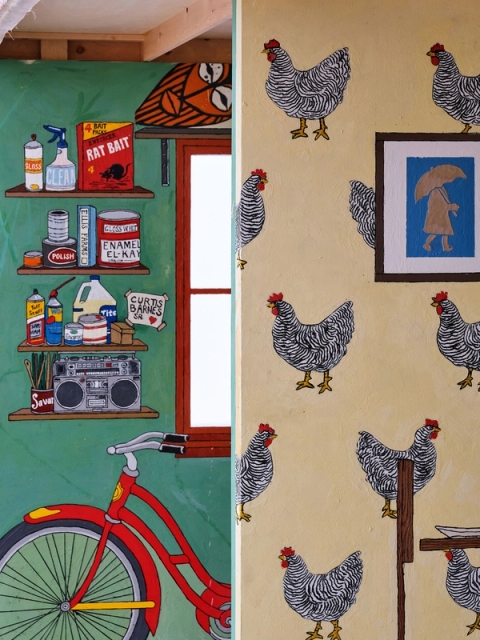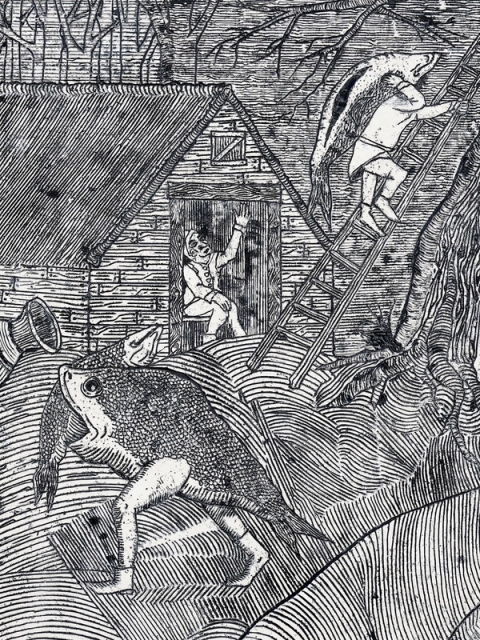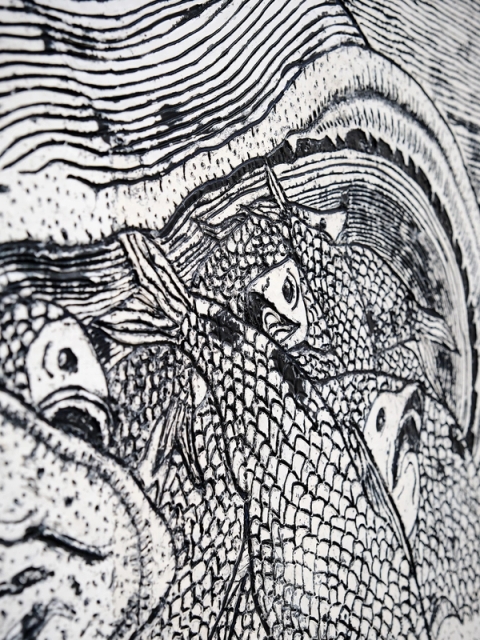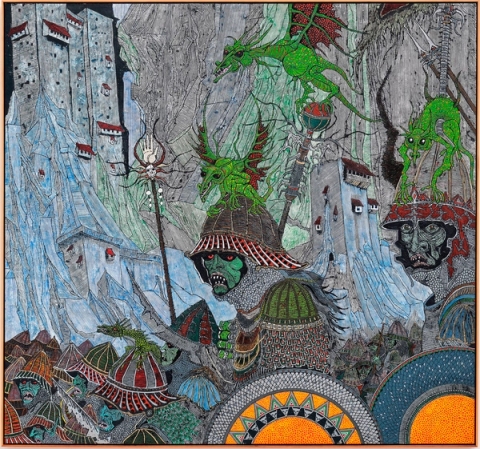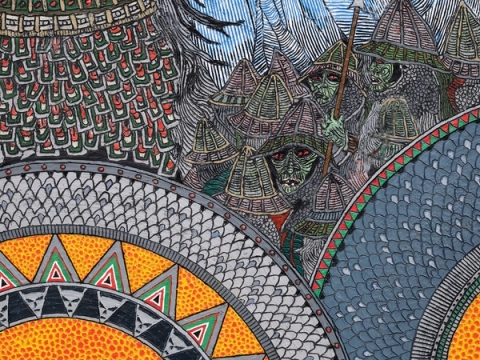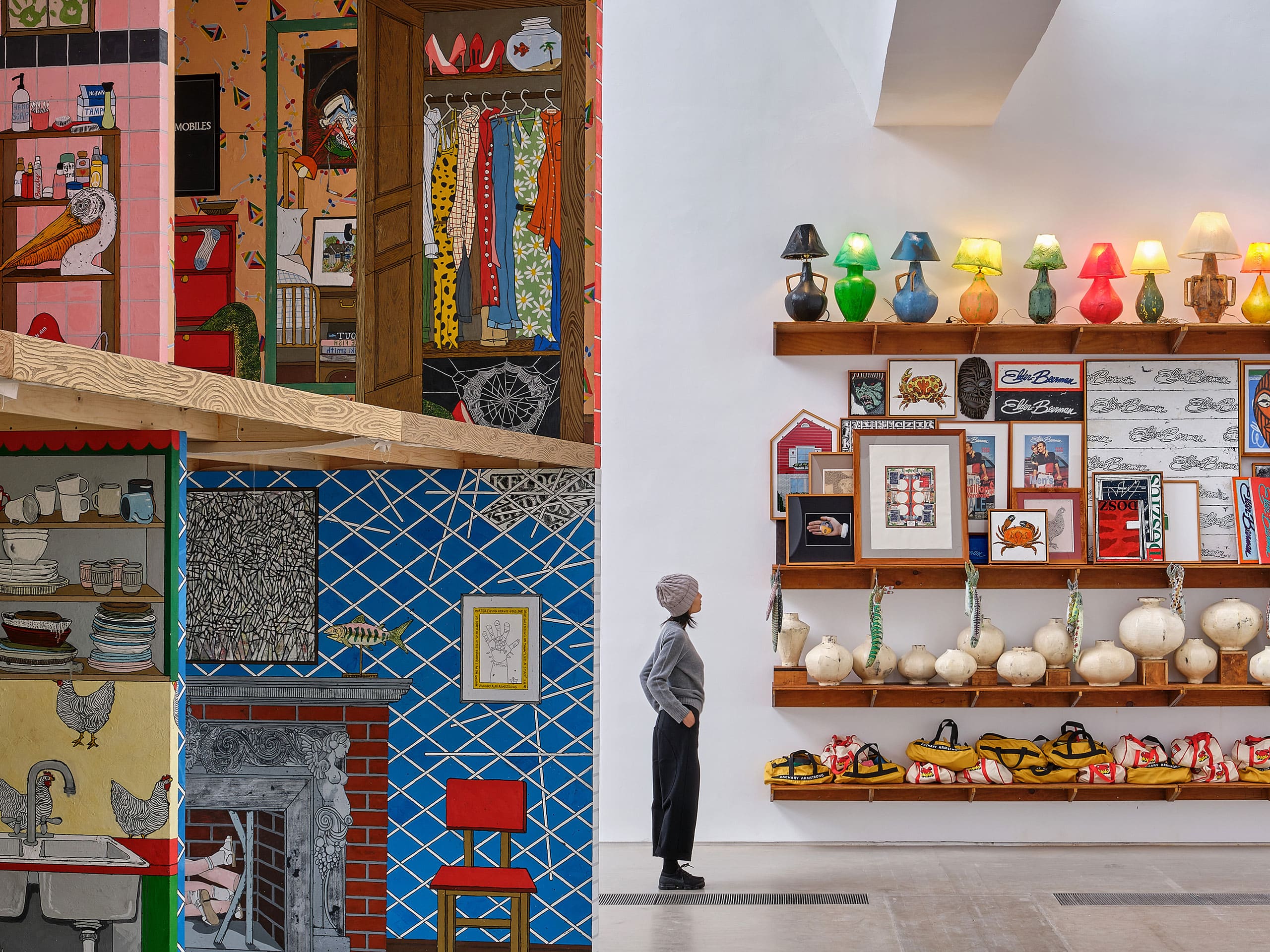
"Bag of Candles" is the first solo exhibition by American artist Zachary Armstrong in China and is his most comprehensive exhibition to date.
For the exhibition, Armstrong has created a new body of work, including bags stuffed with hand-crafted wax candles, a life-size bronze cast of a t-rex skull and a walk-in model of a doll house built of wax painted canvases. The result is a vast assemblage of remarkable objects – a contemporary Wunderkammer - spanning from Armstrong’s densely storied drawings to his simple pottery work and naive cartoonish imagery of his wax paintings and sculptural works.
Through Armstrong’s material-oriented approach and diverse range of techniques, sensibility, image and process are experienced as one in his works. With the wax candle works at its heart, the exhibition delves into materiality as a structure for exploring the personal in Armstrong’s works. Wax is a key material in Armstrong’s practice and the candles are for the artist a symbol of childhood memories as he would collect them as a child. In the exhibition, the candles become a symbol of obsessive collecting, which is inherent in the long tradition of collecting practices of museums and in the consumerist culture of the contemporary world at large.
Accumulations, build-ups, collections and repetitions peek through everywhere in the exhibition where Armstrong’s use of the same figures and motifs are repeated across various media, always entering new relations and unavoidably changing character and form. For Armstrong, one work is always a study for the next, be it the reproduction of a fish painting, the Elder-Beerman logo, or pop cultural imagery, such as dinosaurs and sheep, commonly found in commerce’s youth products.
In Bag of Candles, Armstrong exposes the personal in relation to the outside, commercialized world and explores how it interferes with our imagination and everyday life. In Armstrong’s works, meaning is always ambiguous, and the form is always flexible, opening up to a universe of ever-evolving transformation of materials and motifs, which is at the same time surprising, serious and playful.

The dinosaur has been a reoccurring motif in Armstrong’s works. Armstrong once had a bedsheet with dinosaurs, and he later recreated them in paintings, which his son would refer to as the “dinos”. In this exhibition, Armstrong has made the dinosaur a more realistic and striking figure, with the bronze sculpture and this enlarged image of a t-rex.
Armstrong often repeats symbols and images that he likes, to the extent where they get assembled in the obsessive way of collecting which Armstrong experienced as a child and now recognizes in our modern society. Artists, such as Warhol, were also seen using this method, to keep rehearsing and getting better at the concepts or techniques that had potential. This kind of repetition is often seen as problematic in the artworld, since, contrary to other aspects of society, art is expected to be unique.
The sculpture, Maximo, is a life-size cast of a tyrannosaurus rex skull. While the dinosaur as an image is not new to Armstrong’s practice, it is interesting to note that for this artwork the artist has chosen to work with a real-life duplicate and not a cartoon, children’s drawing or imagery from popular culture. The sculpture is named after the artist’s son, emphasizing the personal as well as the childish and playful aspect of the work. At the same time, Armstrong plays with the contradictory nature of the sculpture, representing the familiar and the uncanny, making a dream perhaps too realistic by materializing it.
The dinosaur image is a beloved motif by Armstrong, since he has both created paintings with and named an exhibition after the extinct animal. For Armstrong, repetition is an important part of his practice and the artist often reiterates the same subjects, repeating what works and striving to always make some improvements. With the t-rex scull, Armstrong has taken another step in repeating the image of the dinosaur.
Untitled Yellow, 2019
Encaustic on canvas
235 x 273 cm
Maximo, 2018-19
Bronze
91 x 84 x 150 cm
The idea for the "Encaustic House" derived from a doll house that Zachary Armstrong received from an old friend. The house reminded the artist of his childhood and the concept of home, but for some reason it felt unfulfilled to him.
Hence, for 15 years he dreamed of bringing the house to life and to its full potential. Instead of recreating a version of the house in a painting, Armstrong decided to make a life-size installation, which contains both an elaborately painted outdoor facade and the interior part.
The house consists of double-sided painted panels crafted in the encaustic technique that Armstrong is known for. Through the ancient technique of encaustic wax painting, Armstrong achieves a layering effect in his works by applying layers of hot beeswax mixed with pigments to the canvases. The encaustic technique was revived and popularized by artists such as Jasper Johns, Jackson Pollock, and Lynda Benglis through the 20th century. Much like a candle, encaustic becomes solid when it cools, allowing the artist to cut, carve, stamp and sculpt it. The surfaces of Armstrong’s canvases are thick and clotted, acquiring the spontaneity and simple aesthetic of a child.
Each panel of the house is handmade, like all other canvases he uses. The house is loaded with symbols and images familiar to most people, no matter where you are from, associated with the idea of the comfort of home, such as pots and pans, a toothbrush, books and pictures on the wall. However, there are also elements that challenge the notion of an ideal home: uncanny and scary things like monsters under the bed, legs in the fireplace, and a mermaid’s tail in the bathtub. Together these components make up the sum of a house and of one’s life. The familiar and the unfamiliar details symbolize the good and the bad memories, and thus make one’s experience of exploring the Encaustic House a mix of ease and unease.
The smaller work on show “Old Wooden House” (2019) is a model of the doll house from which the Encaustic House was built.
Encaustic House, 2019
Oil and encaustic
500 x 305 x 671 cm
Consisting of shelves with over 200 pieces of lamps, pots, paintings, sketches and bags with candles, the large shelves piece is a mural representing Armstrong’s artistic practice as a whole, with cross-references to other works in the exhibition. Every painting has its counterpart in a sculpture in the exhibition and/or references another work by Armstrong.
As the central element and heart of the exhibition are the bags of candles. The material, beeswax, although in different forms, is used in nearly every piece in the exhibition and in Armstrong’s practice: in the Encaustic House, the paintings, the pots and lamps, and the smaller studies and sketches.
Armstrong collected various objects as a child, one of them being wax candles, which he would stack and preserve, just for the sake of collecting. Today, the wax material is a central element in his works, while the aspect of collecting is emphasized in the overwhelming number of pieces used to comprise this installation. The latter also represents a comment to the excessive and obsessive nature of collecting in our society in general.
The installation is arranged like a display at the French art salons in the 17th-20th century: with a massive quantity of works. For Armstrong there is an irony and conflict in today’s society where goods are regularly reproduced and sold in abundance, except for in the artworld, where an objects uniqueness is valued. Again, Armstrong goes against this “flow” and repeats the things that work for him to strive for perfection.
At the top level of the shelves, the lamps light up the entire installation like American billboards or museum lighting that lights up an artwork. This way, the installation conveys a mix of references from high vs. low culture, mass productions vs. craftmanship, pop culture vs. fine art, to personal vs. professional life.
Mural, 2020
Mixed materials
Dimensions variable

Big Fish after Bruegel is an encaustic painting made after Pieter Bruegel the Elder’s (the Netherlands, ca. 1525–1569) work Big Fish eats Little Fish, made in 1556. The original painting is known as one of the most haunting of Bruegel's images, and is among the first of the artist's many interpretations of proverbs in paintings or prints.
The image depicts many small and large fish tumbling out of the mouth of an enormous beached fish. A small, helmeted figure with an oversized knife slices open the big fish's belly, revealing more marine creatures inside. The surrounding landscape seems to be overrun by a mystical assortment of real and fantastic fish. In the foreground a man accompanied by his son gestures towards the scene, seeming to be the one who understands the morale of the event.
By recreating this image, Armstrong equals out the art historical hierarchy by hanging a reference image of an artistic heavyweight like Pieter Bruegel next to the images sourced from less acknowledged artists such as Ian Miller, known as a fantasy illustrator in popular culture. By initiating meetings like this, Armstrong creates new dialogues across boundaries of time and artistic style, and sheds light on an artist who wouldn’t usually be recognized on the contemporary art scene.
Big Fish after Bruegel, 2019
Oil and encaustic on canvas
338 x 224 cm

The original painting by Norman Rockwell that Armstrong references is called New Television Antenna. It appeared on the cover of The Saturday Evening Post published on November 5, 1949.
Another title for the painting is New Television Set, and it shows a new television enthusiast having his antenna installed. The general public in America started buying televisions and, with them, television antennas, during the late 1940's.
Norman Rockwell (1894 – 1978) was an American painter and illustrator. His works have an extensive popular appeal in the United States for their reflection of American culture. Rockwell is most recognized for the cover illustrations of everyday life he created for The Saturday Evening Post magazine over nearly five decades.
Rockwell's career with the Post spanned 47 years, from his first cover illustration, Boy with Baby Carriage, in 1916 to his last, Portrait of John F. Kennedy, in 1963, making him a well-known and beloved illustrator of the American culture.
The original oil on canvas painting is currently part of the collection of The Los Angeles County Museum of Art, but once again, Armstrong gives this artist an opportunity to have place in a different part of the art world by recreating one of his works.
Rockwell, 2019
Oil and encaustic on canvas
258 x 231 cm
The painting, Double Warrior, is an ode to the British fantasy illustrator and writer Ian Miller (1946). Miller is most known for his unconventional etched gothic style as well as gloomy sensibility and has been recognized for his book cover, magazine cover and interior illustrations.
The original painting referenced by Armstrong is called Battle of the Hornburg and is an illustration from the book The Characters from Tolkien by David Days. The battle at Hornburg at Helm’s Deep was the first great battle in the Lord of the Rings trilogy, and the painting depicts some of the evil wizard’s, Saruman’s, forces – orcs – ready for the combat.
Ian Miller is known for his surreal, gothic, nightmarish or even grotesque style, and for drawing freely from his imagination without any reference material. This kind of seemingly easy way of painting without overthinking is something Armstrong also strives for and what he admires other artists for. By recreating one of Ian Miller’s pieces, Armstrong places him in a context which is unusual for Miller.
Double Warrior, 2019
Oil and encaustic on canvas
232 x 217 cm

Group Exhibition
The Red Bean Grows In The South
